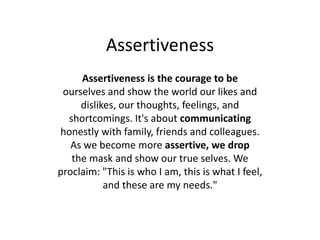
Assertiveness
- 1. Assertiveness Assertiveness is the courage to be ourselves and show the world our likes and dislikes, our thoughts, feelings, and shortcomings. It's about communicating honestly with family, friends and colleagues. As we become more assertive, we drop the mask and show our true selves. We proclaim: "This is who I am, this is what I feel, and these are my needs."
- 2. Assertiveness When faced with interpersonal problem, some people may feel inferior to others or fear their power. Under these conditions they are likely to suppress their feelings or openly rebel and strike out in anger. Neither response is truly productive. The objective of Assertiveness Training is to help people to develop effective ways of dealing with a variety of anxiety producing situations.
- 3. Assertive Person Assertive people have the following characteristics: They feel free to express their feelings, thoughts, and desires. They know their rights. They have control over their anger. It does not mean that they repress this feeling. It means that they control it for a moment and then talk about it later in a logical way. They have a good understanding of feelings of the person with whom they are communicating.
- 4. Aggressive Person THE AGGRESSIVE PERSON • Expresses point of view arrogantly, as if no other is possible. • Tends to dismiss or ignore the opinions and feelings of others. • Believes one's own needs are most important. • Feels powerful when dominating others, later guilty or remorseful as people draw away. Example: "Anyone with any sense would know that's a ridiculous point of view."
- 5. Passive/Aggressive Person THE PASSIVE/AGGRESSIVE PERSON • Agrees to others' demands, then avoids by making excuses, forgetting and being late. • Denies personal responsibility for their actions, uses accusatory statements. • Tries to get his/her own way by being manipulative • Fears rejection and confrontation. Example: "Yes, I know I promised to meet you at 9.00, but Anthony kept me talking. I'm really sorry."
- 6. BEHAVIOUR ASPECTS Assertive people are Direct, honest and expressive. They feel confident, gain self respect, and make others feel valued.
- 7. BEHAVIOUR ASPECTS Aggressive people may humiliate others, and unassertive people elicit either pity or scorn from others.
- 8. Assertive people learn to • Express their feelings, • Ask for favours, • Give and receive complements, • Request behaviour changes, and • Refuse unreasonable requests.
- 9. When confronted with an intolerable situation Being assertive involves 5 stages. Stage Example 1. Describe the behaviour. “When you do this.....” 2. Express your feelings. “I feel..........................” 3. Empathize. “I understand why you....” 4. Negotiate a change. “I want you to ...........” 5. Indicate consequences. “If you do(don’t ), I will....” Not all the steps may be necessary in all situations.
- 10. Body language as related to assertive behaviour: Eye contact and facial expression: Maintaindirect eye contact, appear interested and alert, but not angry. 2. Posture: Stand or sit erect, possibly leaningforward slightly. 3. Distance and contact: Stand or sit at a normal conversational distance from the other.
- 11. Body language as related to assertive behaviour: 4. Gestures: Use relaxed, conversational gestures. 5. Voice: Use a factual, not emotional tone of voice. Sound determined and full of conviction, but not overbearing. 6. Timing: Choose a time when both parties are relaxed. A neutral site is best.
- 12. EFFECTIVE ASSERTIVE BEHAVIOUR Assertive behaviour generally is most effective when it integrates a number of verbal and non verbal components. Appropriate gestures, congruent facial expressions are essential, and strong but modulated voice tone and volume will be convincing. Perhaps most important is the spontaneous and forceful expression of an honest reaction.
- 13. MAKING REQUESTS One useful technique is the Describe, Express, Specify and Outcome script. These four steps can be used when learning to make an assertive request. The intent is to frame the situation, say what's wrong, make your request and predict an outcome.
- 14. DESCRIBE Before making a request, define the situation. What's going on? Helpful description: Assertive person: "It's been a long time since we went out for dinner together." Unhelpful description: Passive/passive, aggressive person: "Why don't you ever take me out to dinner any more?"
- 15. EXPRESS Here and now, express how you are feeling in this particular situation: Assertive: "I miss you…“ Passive/passive, aggressive: "You don't love me any more."
- 16. SPECIFY Indicate what you would like to happen: Assertive: "I would love to go out on Saturday." Passive/passive, aggressive: "I don't suppose you're free on Saturday, either…"
- 17. OUTCOME Describe the outcome you'd like to achieve if the other person went along with your request: Assertive: "It would be a great chance for us to catch up and spend some time together.“ Passive/passive, aggressive: "Like always, you're letting me down."
- 18. Assertiveness 1. Assertive responses are characterized by the use of ``I'' statements instead of ``You'' statements. 2. Assertive responses are usually effective in getting others to change or reinforce behavior. 3. Assertive responses run a low risk of hurting a relationship. 4. Assertive responses neither attack the other's self-esteem nor put him on the defensive. 5. Assertive behaviour prevents ``gunny sacking,'' i.e., saving up a lot of bad feelings.
